|
|
|
|
|
This article is courtesy of |
|
|
|
||||||||||||||||||||||||
|
Fulca 2002
|
|
||||||||||||||||||||||||||||||
|
|
MiG Brother is watching you... |
|
|||||||||||||||||||||||||||||
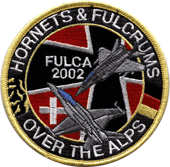 |
|
|
|
|
|||||||||||||||||||||||||||
| Recently German MiG-29s deployed to Switzerland to perform air combat training missions with the F/A-18C/D Hornets. Koen Aerts/Aero Topics analyses the 'Alpine close encounters' and reports on Germany's Fulcrum era, which is about to come to a close |
|
||||||||||||||||||||||||||||||
| On 17 April last, another milestone was set in Swiss aviation history when for the very first time the legendary MiG-29 deployed to this Central-European Alpine state. Invited by the Schweizer Luftwaffe or Swiss Air Force for a two-week lasting exercise, German Luftwaffe Fulcrums were to perform their best |
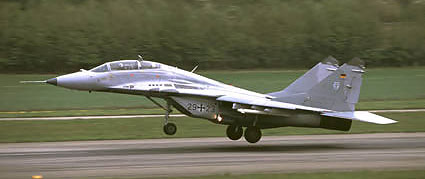 |
|
|||||||||||||||||||||||||||||
|
|
against the fighter pilots of Switzerland's Hornet-equipped Staffel 11 "Tiger" Squadron. Although primarily tasked with the air defense role, the Laage-based MiG-29s are more often - if not constantly - called upon by Western squadrons for DACT - Dissimilar Air Combat Training - exercises to confront their pilots with the much-feared Russian myth. To make the necessary arrangements for Fulca 2002 (Fulcrum Campaign), as the exchange event was baptized, one German two-seater MiG-29UB pre-visited Dübendorf's "Tigers" on 13th February. |
|
|
|
|
||||||||||||||||||||||||||
| In line with its neutral status and non-alignment with other countries Switzerland is obliged to maintain a proper military force, capable to solely defend Swiss territory in times of conflict. To bring its Air Force to these standards, Swiss pilots often deploy abroad to train with surrounding countries in the air defense role. One example is Waddington's ACMI range, where Swiss authorities annually book several slots, giving their pilots the possibility to keep tracks with the latest air combat tactics. Furthermore, participating in exercises like Amadeus in Austria allow the Swiss Air Force to have an insight in combined missions with 'allied' forces. Inviting foreign air forces to their home front for air combat training over the snow-covered Alps was a rare occasion before the turn of the century. Today, the Schweizer Luftwaffe realizes that a full use of the Hornet's air defense capabilities can only be explored through co-operation and information exchange with foreign fighter units. In this respect joint training with neighboring states (France, Germany, Austria and Italy) is set as a priority in the co-operation with other air forces. This 'internationalization' process brought in August 1999 seven Austrian J-35OE Drakens to Payerne airbase for a one week lasting squadron exchange. As a sequel to this policy the recent Fulca 2002 exercise, held from 15 April to 3 May at Dübendorf airbase, near the city of Zürich, gave the Swiss Hornet drivers the means to put themselves to the test with the German MiG-29s. Whereas the main objective of the German pilots was to learn more about air combat maneuvering at high altitude in the Alpine region, the Swiss pilots were more interested in measuring the Hornet's strengths and weaknesses when confronted with this Russian legend. During the less hectic weekends sightseeing tours and other social events gave the 'Tigers' the chance to tie new relationships with their Northern neighbors. |
|
|
|
||||||||||||||||||||||||||||
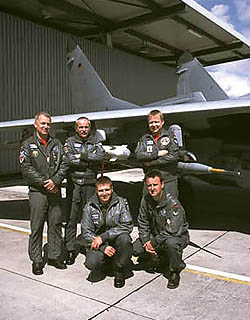 |
|
||||||||||||||||||||||||||||||
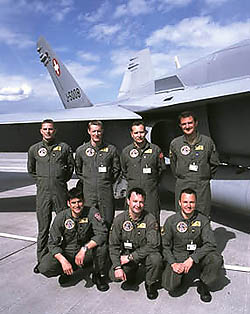 |
|
||||||||||||||||||||||||||||||
| MiG-29, the gift from God. While on 9 November 1989 many East-German citizens were exuberantly celebrating the fall of the Berlin Wall, the Western military was already eye-balling at the aerial assets of the NVA – Nationale Volks Armee or East German Armed Forces. NATO was in particular very eager to get their hands on the 24 newly acquired MiG-29 aircraft, which had rejuvenated NVA's JG 3 - Jagdgeschwader 3 'Wladimir
Komarow', Preschen airbase, only one year before. A 1 billion GDR Marks contract included 20 MiG-29A and four MiG-29UB two-seater trainers, which were all delivered between May 1988 and January of the next year. Although a follow-on contract for 32 additional Fulcrums was signed to replace the MiG-21 Fishbeds of the Holzdorf-based JG 1 'Fritz Schmenkel', Mother-Russia banned further sales as
the German Reunification came closer, fearing what was about to come true. |
|
||||||||||||||||||||||||||||||
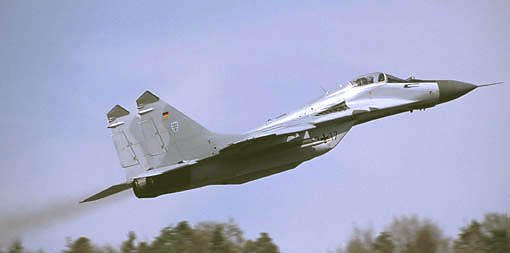 |
|
|
|
|
|||||||||||||||||||||||||||
 |
|
||||||||||||||||||||||||||||||
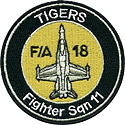 |
|
||||||||||||||||||||||||||||||
| Very eager to put the latest 'Red Threat' technology to the test, NATO specialists' patience was tried until November 1990, when the NVA officially ceased to exist and all assets were assimilated in the newly consolidated German Luftwaffe. At the time very little was known about the novelties
the Fulcrum incorporated, and this ignorance made the MiG-29 the most-feared Russian fighter. Since tensions in the Gulf region might lead to Iraqi MiG encounters, the Warsaw Pact present came as a God's gift. To divulge the Fulcrum's secrets, the aircraft was submitted to a six months lasting evaluation program to explore its performance limits and to analyse its air defence capabilities when
flying DACT missions with and against Western aircraft. After some 385 sorties and 300 flying hours, the conclusions of the 50 cm high staple of detailed reports were distilled into a 13 pages long analysis, which in turn was submitted to the cabinet of Defence Minister Gerhard Stoltenberg. The German Government decided on the integration of the Fulcrum fleet in the Luftwaffe inventory for a
period of twelve years. To fulfil their role in the national air defence the German MiG-29s needed various adjustments necessary to operate in NATO structure. All 24 aircraft past through the three years lasting ICAO 1 upgrade program, which was concluded in 1995. Apart from the air superiority grey colour scheme, IFF, TACAN and free selectable VHF/UHF radios were installed. Furthermore
collision warning lights and emergency communications were incorporated, while inside the cockpit the metric system and Russian language were replaced by English standards. Due to the proximity to the Polish border, MiG-29 launches from Preschen obliged the aircraft to enter Polish airspace, much to the dislike of the local authorities. Therefore, in 1995 the Fulcrums relocated to Laage
airbase, Northern Germany, to equip Staffel 1 of the newly established JG 73 'Steinhoff'. Two years later the Pferdsfeld Phantoms of JBG 35 were also relocated to Laage, forming JG73/Staffel 2. |
|
|
|||||||||||||||||||||||||||||
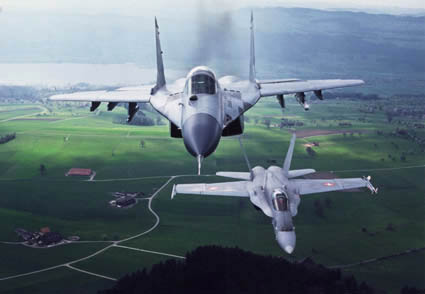 |
Although primarily tasked with a role in the German air defense system, the 'MiG-29 drivers' saw themselves evolve into a very different player. Obsessively trained to counter Russia's latest generation fighters, the ultimate Fulcrum confrontation was - and still
is - every Western fighter pilot's dream. Consequently JG 73 was overwhelmed with requests for squadron exchanges to act as a sparring partner in aerial duels. With help from the most experienced German AMRAAM operating F-4F pilots, new MiG-29 tactics were developed, based on western ACM - Air Combat Maneuvering - techniques and AIM-120 characteristics. Russia's latest generation fighter
combined with the use of Western tactics and knowledge made JG 73's aircrew without doubt the best MiG-29 pilots in the world. |
|
|
||||||||||||||||||||||||||||
|
|
|
|
|
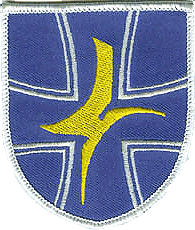 |
|
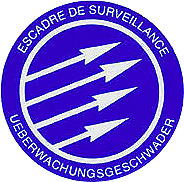 |
|
||||||||||||||||||||||||
| Whereas the 90 people strong German contingent arrived in Dübendorf on 17th April, first missions were scheduled two days later. This gave both parties the opportunity to study the flight schedule of the following two weeks and, more important, to get to know each other. The most striking difference between the 'opponents' was the generation gap. Similar to the age difference between the German Fulcrums and the Swiss F/A-18s, the Hornet drivers of the Ueberwachungsgeschwader (UeG) or Air Surveillance Wing are considerably younger than their German colleagues. Although the Swiss Air Force previously consisted of mixed squadrons of militia and professional pilots, the Hornet-equipped Staffels 11, 17 and 18 of the UeG are composed of only young full-time professionals. Reason for this shift from a partly militia crew to full-time pro's is the F/A-18C/D being too complex for interim use. The first Fulca 2002 missions were conducted on 19th April in the form of familiarization flights, during which the MiG pilots, who normally operate over the North-German plains and the Ostsee, were introduced to the breathtaking alpine scenery. More important were the low approaches over several South-Swiss airbases, which in case of technical problems or bad weather situation during the numerous 'hops' would act as emergency landing locations. Since most of these reserve airbases are located in narrow valleys, overshadowed by towering mountain ranges, special approach procedures are operative and wind is a very important parameter. Although the German pilots studied these 'acrobatic' landing procedures to the detail, the two weeks lasting exercise proved incident-free. |
|
||||||||||||||||||||||||||||||
| Short-sighted, but lethal' During the first training week basic fighter maneuvering, i.e. air combat within visual range, was practiced and the dogfight intensity was gradually built up during the first five days from 1v1 to 2v1, concluding in 2v2 on 26 April. Like many MiG opponents during previous DACT exercises, the Swiss underestimated the Fulcrum's qualities at close range. Like the Hornet, the MiG-29 has great low speed maneuverability, |
|
|
|
||||||||||||||||||||||||||||
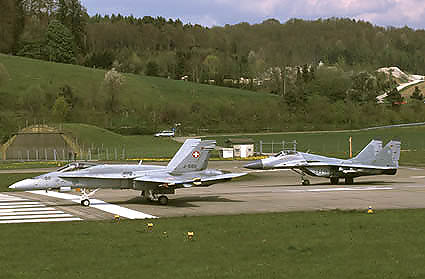 |
|
||||||||||||||||||||||||||||||
|
|
|
which allows it to move its nose around in slow-speed fights. The aircraft's greatest advantage is the AA-11 Archer, a Russian-built infra-red guided missile, which in combination with the pilot's helmet-mounted sight makes the Fulcrum the most feared lethal weapon. This helmet-mounted sight consists of a monocle over the left eye and sensors on helmet and in the cockpit to detect the pilot's head position. Just by looking at the target the pilot can activate a firing solution and the thrust-vectored Archer can be launched up to 45° off the MiG's nose. This superiority is only effective if the enemy is seen as soon as possible. One of the Fulcrum's disadvantages is the visibility from the cockpit. The Hornet drivers soon realized that the MiG-29 pilots had difficulties 'checking six'. Since an Archer launch includes illuminating the target until impact, the pilot has to keep his head turning towards the target, a very tiresome procedure when performed in heavy G dogfights. Thirdly, the Fulcrum's cockpit avionics entail considerable workload with a lot of hands-off switches and limited HUD information. When looking inside his cockpit, the MiG-29 pilot is not able to continuously monitor his tactical situation. These elements gave the Hornet drivers the means to tackle the MiG-29's splendid close-range superior performance and partly overcome the Archer off-boresight launch authority. |
|
|
|||||||||||||||||||||||||||
|
|
|
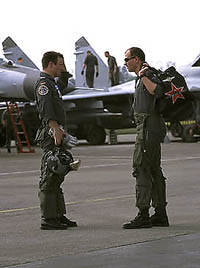 |
|
||||||||||||||||||||||||||||
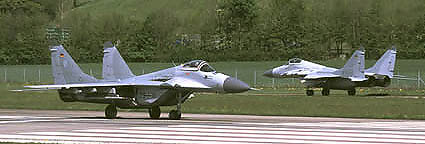 |
|
||||||||||||||||||||||||||||||
| The Fulcrum's greatest disadvantage was unveiled during the second week, when 4v4 BVR (beyond visual range) 'hops' were performed. Although the MiG-29's radar has a 120° detection capability, only a 50° cone can be used for target detection and tracking. Clearly, this does not give the pilot a good overview of the tactical situation. Since the radar has to be manually steered towards the target's direction, |
|
||||||||||||||||||||||||||||||
| the pilot greatly depends on GCI information to locate the bogey. During lock-on all other contacts are lost and no target altitude, range or speed information is provided. The second BVR drawback is the use of the AA-10 Alamo, a semi-active radar guided missile which needs target illumination until impact. The Alamo's performance can be compared with its outdated Western counterpart, the AIM-7 Sparrow. Clearly, the AMRAAM-equipped Hornets were in the advantage here. During the last two days of the exercise the scenario changed into 4v2+2, meaning four Hornets against two MiG-29s and a pair of F-5E Tigers. During these setups the Hornet pilots were less successful than earlier in the week, since the radar of the interceptor F-5Es can cover a wider angle during search mode than the Fulcrum. This feature provided a much better overview of the tactical situation and the Fulcrum drivers could be directed to their targets by communicating the bogeys' co-ordinates. |
|
|
|||||||||||||||||||||||||||||
|
|
Thirsty machine. During Fulca 2002 F-5E/F and Mirage IIIRS sorties were strongly reduced partly to minimize the noise pollution over Dübendorf's surrounding villages. More important, these temporary regulations freed technicians and ground personnel to ensure a higher service level of the F/A-18 fleet. The Hornet's low maintenance needs - one flight hour equals about 25 man hours of maintenance work - added to the high operational status throughout the exercise. In this field the German counterparts were in for a challenge, since one MiG-29 flight hour requires no less than 80 man hours of servicing. Although during the exercise the objective was to have six Fulcrums operational at all times, the Germans ferried eight aircraft to Dübendorf to absorb this Giant's work. Daily many DACT 'hops' were scheduled, averaging to about fourteen MiG-29 sorties per day, but these numbers have to be put into perspective. Each mission comprised a maximum of 25 minutes flying, which unveiled the MiG-29's Achilles heel. Being a real gas guzzler, the Fulcrum's autonomy is very restricted and considered a major worry in its air defense task. Mass-produced in a Cold War period, the Russian aircraft was mainly designed for scramble missions to intercept an intruder. Due to its limited autonomy the Fulcrum hardly fits into today's changed geopolitical strategies, where fighter aircraft are tasked with CAP (Combat Air Patrols) missions and long-range fighter escorts. Although the installation of a centerline external fuel tank (EFT) can increase the aircraft's autonomy, this configuration has numerous downsides. Since the EFT blocks the discharge route of spent ammunition casings, the tank has to be jettisoned when using the 30mm cannon. This configuration also limits the aircraft's speed to 1.5 Mach and disables the activation of speed brakes. To partly overcome these problems modifications to seven single-seaters enabled the use of two 300 gal (1150 litre) under wing pylons. This configuration however limits the Fulcrums maneuverability to 4 G turns. |
|
|
||||||||||||||||||||||||||||
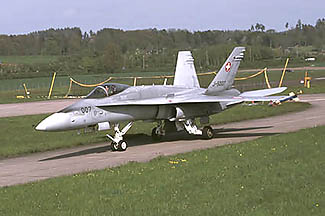 |
|
||||||||||||||||||||||||||||||
 |
|
||||||||||||||||||||||||||||||
|
|
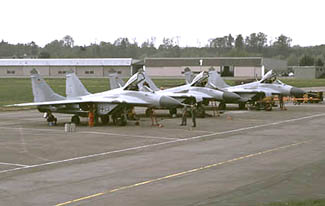 |
|
|||||||||||||||||||||||||||||
|
|
|
Fulcrum force, last call? Since the German Fulcrums remain Europe's most solicited sparring partners in DACT exercises, they have accumulated many flight hours and are considered the world's most extensively used MiG-29s. In line with its planning to operate these aircraft for a period of twelve years, the German Luftwaffe has elected JG 73 to become the first Eurofighter Wing in its inventory. Whereas the Phantom-equipped JG73/St2 has been disbanded in March this year to free its pilots for Eurofighter conversion training in Manching, the Wing's first squadron will operate the Fulcrum for another two years. This year the Germans will deploy to the USA to visit Nellis AFB, not for participation in Red Flag, but to operate with F-15s and F-16s of 422th Test and Evaluation Wing. During this 'tour' JG73/St1 will furthermore fly against US Navy F-14s and F-18s during their four weeks stay at Key West. Although in 2003 part of the Fulcrum pilots will also start their Eurofighter conversion course, the unit will that year participate in a missile test program at Tyndall AFB. Further vague plans include squadron exchanges with Swedish, Finnish and Swiss units. Currently a letter of acceptance has been signed by the Polish Government to acquire all 23 remaining Fulcrums - one MiG-29 crashed in June 1996 - for the symbolic amount of 1,00 Euro, augmenting the Polish fleet of 22 MiG-29s. Officially the German Luftwaffe will withdraw the Fulcrum fleet at the beginning of April 2004, and if current talks with its neighboring state materialize, German MiG-29s will soldier on with the Polish Air Force until 2015. |
|
||||||||||||||||||||||||||||
|
|
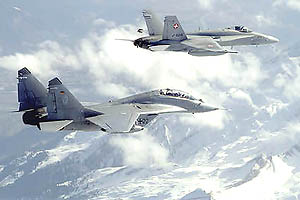 |
|
|
||||||||||||||||||||||||||||
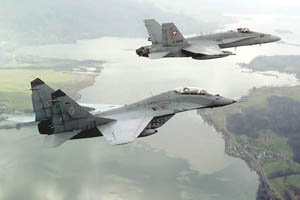 |
|
||||||||||||||||||||||||||||||
|
|
|
|
|
|
|
|
|
|
|
|
|
|
|
|
|
|
|
|
|
|
|
|
|
|
|
|
|
|
|
|
|